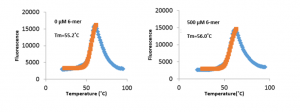In my last post, I determined that fluorescence polarization with different lengths of ubiquitin peptides was not a viable assay to screen compounds. I wanted to see if the ubiquitin peptides of different lengths resulted in a thermal shift of the USP5 Zf-UBD in a differential scanning fluorimetry assay. Experimental details are on Zenodo. As suspected from the fluorescence polarization assay results, increasing the length of ubiquitin peptides did not improve the stabilization of the peptide to the USP5 Zf-UBD as no thermal shift is seen with high concentration of the peptides (Figure 1).

Figure 1. Representative regression charts of the highest and lowest concentration of 6-mer ubiquitin peptide (LRLRGG)
Therefore, neither DSF nor FP will be used as a primary screening assay. I am currently working on purifying fluorinated protein for testing with an NMR assay. Stay tuned!

One Reply to “USP5 Zf-UBD Differential Scanning Fluorimetry Assay Development #3”